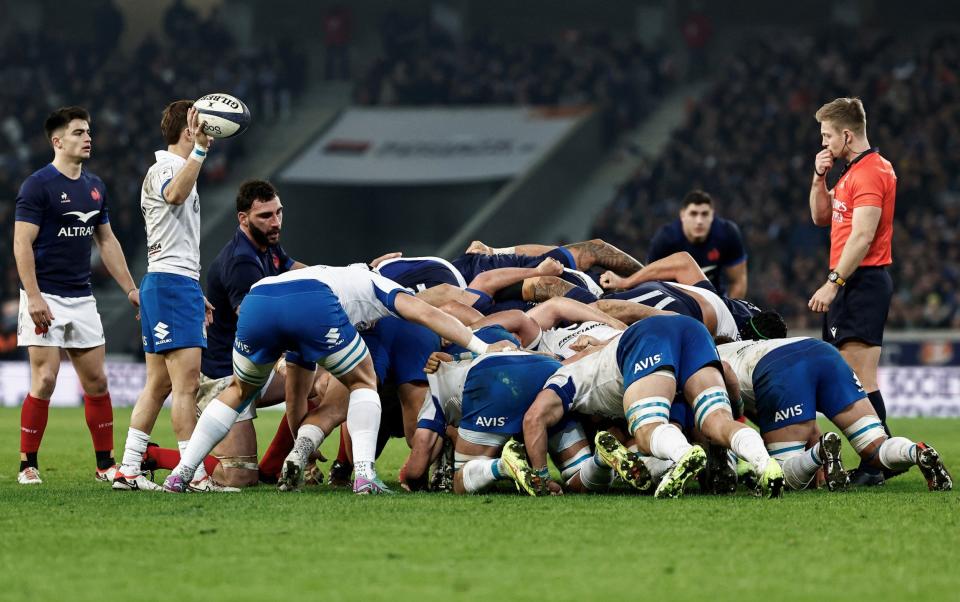Plan to fix rugby is long overdue – here is how it should happen

A few aspects of World Rugby’s five-point plan to attract the next generation will have stung current fans with irony. Because as the global governing body itself knows, part of the battle is to unstitch bad habits that have been entrenched by the elite game.
Put simply, you will not see amateur scrum-halves getting away with the sluggish construction of a caterpillar ruck. Grass-roots referees are far more likely to sanction a team that delays a line-out. And the dastardly ‘croc roll’, which is in direct contravention of law 16b, decreeing that players must not collapse a ruck, is a recent invention of professionalism – having arrived since the practice of jackalling grew in influence.
There was much to admire about the published recommendations from this year’s Shape of the Game conference. Everyone would agree with the need to streamline and simplify rugby’s disciplinary process, which can be hugely confusing. Harnessing the popularity boom of the women’s game, another stated aim, makes perfect sense.
It is understood that the desire for “a consistent approach to the presentation of the sport across all media environments” will centre upon the use of big screens and PA systems to explain refereeing decisions. World Rugby has recognised that all elite matches should do this. Again, this is sound thinking. Some ‘solutions’ should not be described as revolutionary, though.
Caterpillar rucks
How it should be fixed: Referees to call ‘use it’ more quickly.

‘Ball-in-play time’ has become a fetishised statistic in rugby union. The higher it is, the better the game, right? Well, not necessarily. World Rugby is aware that ‘ball-in-flow time’ is more significant. Stats Perform clocked 18 minutes and 38 seconds of ball-in-play time across the second half of Scotland’s win over England on Saturday. But that does not tell the whole story.
Singling out Ben Spencer is unfair, but England’s replacement scrum-half hit five box-kicks from the base of rucks in that second half. At the first, referee Andrew Brace waited five seconds after the ball had become available, while Spencer added England teammates to the breakdown, to call ‘use it’. Five seconds after that, Spencer finally kicked. Ten seconds, therefore, elapsed without anything meaningful happening. And those 10 seconds would have counted as ‘ball-in-play’ time.
Later, following a carry from Joe Marler, the ball was available with 73.28 on the match clock. Brace called ‘use it’ at 73.39. Spencer made contact at 73.44. That constitutes 15 further seconds of ball in play. In total, 57 seconds of ball-in-play time elapsed between a ruck reasonably presenting the ball and these five strikes happening. That is 57 seconds out of the 18 minutes and 38 seconds that comprises the ball-in-play time for the entire half, just devoted to one player preparing to kick. Sobering indeed.
Happily, the answer lies in existing law. Although he should not have been obliged to save England from themselves, Brace could have been far quicker to call ‘use it’. Law 17 states: “When the ball has been clearly won by a team at the ruck, and is available to be played, the referee calls ‘use it’, after which the ball must be played away within five seconds.” Enforce the first part and caterpillars will become endangered. ‘Ball-in-flow time’ is what should be coveted.
‘Dead time’ at scrums and line-outs
How it should be fixed: Shot clocks for set-pieces.

Scheming before line-outs and setting for scrums are big offenders when it comes to ‘dead time’ in matches. Mauls are fine; they are a live contest and part of rugby union’s fabric. To stick with the Calcutta Cup encounter last weekend, Brace dished out warnings about pre-line-out huddles without following through and sanctioning. A more formal means of timing teams, with a countdown clock like those introduced for place-kicks, as implied by World Rugby’s recommendations, would help officials and provide a consistent measure. If a side wanted to establish a set-piece advantage, they should have to hurry up. That said, scrum safety has to be a factor as well.
Static kicking exchanges
How it should be fixed: Eradicate the ‘Dupont’ clauses of law 10.7, with referees empowered to stop the game if a kicker is injured and unable to put team-mates onside.
Bath very in tune with the Dupont loophole that states you can advance from an offside position once a catcher has travelled five metres.
When Will Muir finally does get a charge-down, though, Gloucester benefit from the ricochet.
Please can we close the loophole? It's trash. pic.twitter.com/PZAao1Spvk— Charlie Morgan (@CharlieFelix) January 7, 2024
The ‘Dupont Law’ is named after France scrum-half Antoine Dupont, who popularised the ploy in Test matches, and allows players to advance from offside positions after an opponent has caught a kick and either moved five metres or passed the ball.
Super Rugby Pacific saw the stasis of the interminable kick-tennis during Bath’s win over Gloucester in January and then the bizarre spectacle of Scotland and France playing back-field musical statues at Murrayfield. Then, for their own competition, they decided to bin the clauses that allow players to advance from an offside position once an opponent has caught the ball and either run five metres or passed the ball. Who could blame them?
Jacques Nienaber, the all-conquering former Springboks coach now with Leinster, labelled the Bath-Gloucester back-and-forth as “one minute of ball-in-play with nothing happening except the ball flying through the air”. Nienaber, incidentally part of World Rugby’s high-performance committee for the men’s game, will know that the aim of kicking exchanges is to open up the pitch and to induce fatigue, which leads to more space. Dupont’s law restricts both flow and fatigue. Few would miss it.

